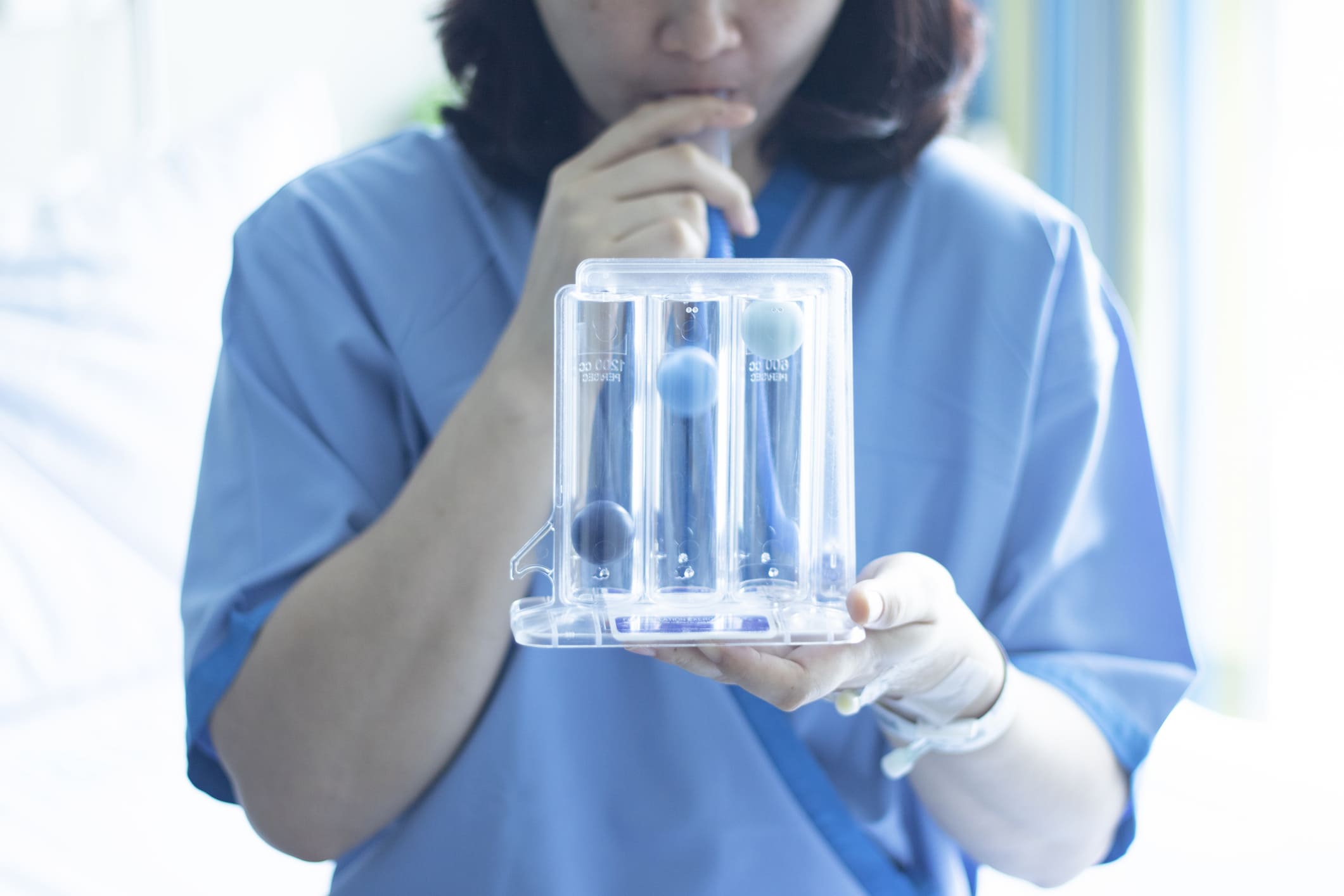Respiratory prehabilitation consists of improving the physical condition of the patient before surgery, improving the respiratory capacity and the respiratory level.
In this sense, at IVOQA we have physiotherapists specialized in oncology who work together with the multidisciplinary team to put each case together in order to establish the best procedure for each patient.
What is respiratory prehabilitation?
Every patient who is going to undergo oncological, thoracic or abdominal surgery should participate in a respiratory prehabilitation program. This program includes respiratory exercises designed to prevent possible post-surgical complications, maintaining airway patency through the use of pulmonary exercise equipment, which facilitates the patient’s early functional recovery.
Good pulmonary health is crucial for the patient’s rapid recovery, since after thoracic or abdominal surgery, lung capacity is significantly affected due to the impact on the abdominal muscle tissues. Equally important is the continuity of postoperative treatment, complementing the work done before surgery.
These exercises are designed to prepare and prevent future complications. The respiratory prehabilitation program at IVOQA includes the use of pulmonary exercisers such as flow-volume stimulators, fluters and restrictors, to encourage expiratory and inspiratory work. In addition, respiratory assist devices such as the Alpha 300, which introduces air into the more distal areas of the lungs, aiding expectoration and thus reducing the chances of lung infection, are used.
Why is it important for oncology patients?
When a patient presents with an oncologic pathology that affects the abdominal area and requires surgery, it is essential to consider the impact of the intervention on respiratory function. Abdominal surgeries can depress important structures such as the diaphragm and temporarily weaken muscles essential for expectoration and coughing, such as the abdominal wall.
Improving the quality of the diaphragmatic muscle before surgery is crucial. A stronger and more efficient diaphragm will allow for better oxygen exchange during postoperative recovery. In addition, strengthening the rectus abdominis before surgery helps to minimize one of the main risks in bedridden patients: the accumulation of mucus secretions. Although mucus is necessary, its prolonged accumulation can become a source of infection.
For its part, prolonged immobility in bed increases the risk of respiratory infections, decreases gas exchange and can lead to a greater need for drugs and a longer hospital stay. This affects not only the patient’s health, but also the patient’s logistics and those of his or her family. In short, the whole biopsychosocial aspect of the patient.
This condition is even more critical in patients with pre-existing diseases, such as chronic obstructive pulmonary disease (COPD) or those with a smoking habit. In these cases, lung capacity is already compromised preoperatively, which means that any surgical intervention can further reduce this capacity.
After surgery, decreased lung capacity can lead to a number of additional complications. Patients with COPD or a history of smoking have an increased risk of developing respiratory infections, as their respiratory system is less efficient at clearing secretions and fighting pathogens. In addition, reduced lung capacity can make it difficult to adequately oxygenate tissues, which can delay healing and overall recovery.
What does a Pre-Respiratory Rehabilitation Program include?
IVOQA’s Respiratory Prehabilitation Program is designed to prepare patients before surgery and continue treatment after surgery. It is not about starting to work in the ICU, but to continue the work started before surgery, ensuring continuity in the treatment. From IVOQA, we have managed to improve the competence of the patient’s musculature and lung tissue, adapting to the new postoperative situation.
Objectives of the Program:
- Improve muscular competence: strengthen the respiratory musculature, especially the diaphragm and abdominal muscles, to ensure better oxygen exchange and facilitate recovery.
- Prevent mucus accumulation: avoid the accumulation of mucous secretions that can become foci of infection, thus reducing the risk of post-surgical complications.
- Reduce the use of drugs and hospital stay: minimize the need for drugs and shorten hospitalization time, improving the patient’s quality of life.
Exercises and Equipment Used:
- Resistometers: this device requires increased effort from the patient to exhale or insufflate air, thus strengthening the respiratory muscles.
- Alpha 300: a respiratory assist device that introduces air into the more distal areas of the lungs, helping to mobilize and expectorate mucus, which reduces the chances of lung infection.
- Abdominal breathing exercises: teaching the patient to breathe abdominally rather than thoracic, optimizing oxygen use and reducing energy expenditure.
- Importance of abdominal breathing: abdominal breathing is more efficient than thoracic breathing, as it consumes less oxygen and energy. In stressful situations, such as after surgery, it is crucial for patients to use abdominal breathing to improve their ability to recover. Devices such as the Alpha 300 help deliver air to the more distal areas of the lungs, facilitating mucus mobilization and reducing the risk of infection.
Every patient is different, as are their conditions and capabilities. Therefore each program is tailored and personalized, and depending on the specific needs of both the patient and their conditions, so will work with both techniques and machines.
Respiratory prehabilitation is an essential part of oncological treatment at IVOQA, especially for patients with cancer affecting the respiratory system, with surgeries that reduce respiratory capacity and lung capacity. The benefits of prehabilitation consist of increasing lung capacity and reducing possible post-surgical complications.
Therefore, adequate pulmonary prehabilitation and continuity of postoperative treatment are essential to improve the patient’s quality of life and facilitate a faster and more effective recovery.












